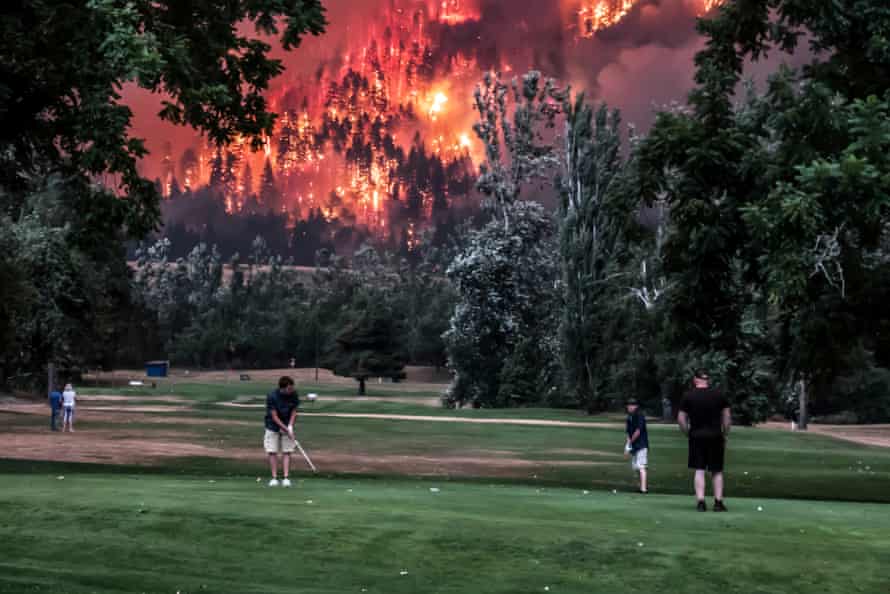In September 2017, David Simon, creator of The Wire, tweeted a photograph of golfers calmly lining up their putts on an Oregon course as wildfires raged in the background. “In the pantheon of visual metaphors for America today, this is the money shot,” he wrote of the picture, which was taken by an amateur photographer who spotted the photo-op as she was about to skydive out of a plane. Everything about this story – the image, the circumstances – seems stranger than fiction.
A year before Simon’s tweet, in a landmark polemic, The Great Derangement: Climate Change and the Unthinkable, Indian novelist Amitav Ghosh had questioned why so few writers – himself included – were tackling the world’s most pressing issue in their fiction. But now, as extreme weather swirls around the globe, melting glaciers, burning forests, flooding districts and annihilating species, the climate emergency has brought the unimaginable into our daily lives and literature. A survivor in Jessie Greengrass’s haunting new novel The High House sums it up: “The whole complicated system of modernity which had held us up, away from the earth, was crumbling … and we were becoming again what we had used to be: cold, and frightened of the weather, and frightened of the dark. Somehow while we had all been busy, while we had been doing those small things which added up to living, the future had slipped into the present.”

Greengrass is among a growing number of novelists who are confronting this unfolding catastrophe through the young genre of climate fiction – or “cli-fi”. Among the new arrivals are the Irish writer Niall Bourke, whose novel Line conjures the Boschian image of refugees queueing for generations in an arid land; and Bethany Clift, whose Last One at the Party is the diary of an unnamed thirtysomething who decides to revel her way to the end, as the sole survivor of a pandemic. In August, Alexandra Kleeman’s Something New Under the Sun will take us to a climate-ravaged near-future California. And in September, Anthony Doerr will follow his Pulitzer-winning novel All the Light We Cannot See with Cloud Cuckoo Land, set between 15th-century Constantinople, Idaho in 2020 and space some time in the future. Doerr has said of the book: “The world we’re handing our kids brims with challenges: climate instability, pandemics, disinformation. I wanted this novel to reflect those anxieties, but also offer meaningful hope.”
So what has changed since Ghosh published The Great Derangement? “I think that the world has changed us, and the inflection point was 2018,” he says now. “It was partly because there were so many extreme climate events that year – the California wildfires, flooding in India, a succession of brutal hurricanes – but partly also because of the publication of Richard Powers’s The Overstory.”
This is a big claim to make for a novel. His point, says Ghosh, is not just about the book itself, but the welcome it received (including being shortlisted for the Booker prize). “It wasn’t hived off into the usual silos of climate change or speculative fiction, but was treated as a mainstream novel. I do think that was a very major thing. Since then, there’s been an outpouring of work in this area. In my own personal inbox, I get two or three manuscripts a day.”
Powers’s Pulitzer prize-winning novel reduces human lives to slim growth rings in the bigger history of trees, with characters whose separate stories fleetingly intersect as they circle around a series of confrontations between individuals and institutions, conscience and greed, that will determine the future of humanity. The Canadian writer Michael Christie repeated this structure two years later in a lively eco-parable Greenwood, set between 1908 and 2038, when a virulent new fungus is killing off all trees in what is known as “the great withering”.
At the heart of both novels is a debate about what constitutes life itself. In The Overstory, a research scientist is cast into the wilderness for daring to suggest that trees have their own forms of consciousness and community, while an entrepreneurial computer geek realises that they hold the secret to everything. In Greenwood, Jake, a tourist guide at a futuristic nature theme park, reflects: “Even when a tree is at its most vital, only ten per cent of its tissue – the outermost rings, its sapwood – can be called alive. Every tree is held up by its own history, the very bones of its ancestors.”



